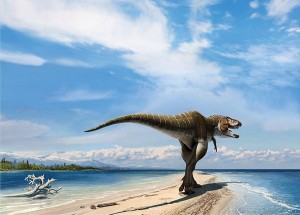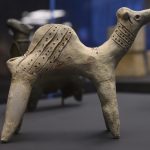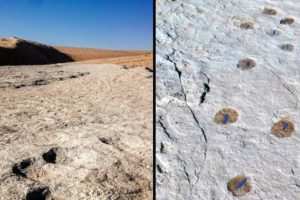
The ancient tyrannosaur resembles T. rex and was found in the Southwest.A newly discovered “King of Gore” tyrannosaur pushes back the origins of T. rex’s terrifying family tree to at least 80 million years ago, report paleontologists.
Lythronax argestes (which literally means “Gore King from the Southwest”) once stalked the shores of western North America in search of prey. It sported the same short snout, broad teeth, front-facing eye, and unimpressive forearms as Tyrannosaurus rex, which lived around 68 million years ago. (Related: “Did the Real T. rex Resemble the One in Jurassic Park?”)
At 24 feet (7.3 meters) long and weighing about 2.5 tons, the 80-million-year-old Lythronax (pronounced LYE-thro-nax) lacked the even-more-massive size of T. rex, says the University of Utah’s Mark Loewen, who headed the team reporting the dinosaur’s discovery in PLOS One.
In comparison, T. rex was about 40 feet (12 meters) long and about 15 to 20 feet (4.6 to 6 meters) tall. (See also “My T. Rex Is Bigger Than Yours.”)
A Regal Discovery
“Obviously we wanted to get ‘king’ in the name,” Loewen says. “Lythronax wasn’t a direct ancestor of T. rex, but they clearly shared a common ancestor, [one] who lived even longer ago.”
That means that western North America, then a separate continent called Laramidia that stretched from Alaska to Mexico, was an original home of the tyrannosaurs.
“Until recently, it looked as if the truly giant, thick-toothed, rounded-snout tyrant dinosaurs appeared really late in dinosaur history,” says dinosaur expert Thomas Holtz, Jr., of the University of Maryland in College Park, who was not involved in the study. “The discovery of Lythronax pushes this body form back,” he says.
Evolutionary Bottleneck
Loewen also points to the way that evolution isolates some species on separate continents. That allows them to develop advantageous features, such as the powerful jaws of tyrannosaurs.
Giants such as T. rex and Tarbosaurus spread across Asia and all of North America during epochs of continental connections, such as the end of the Age of Dinosaurs, which climaxed around 66 million years ago.
A similar pattern seems to have followed for the plant-eating horned “ceratops” dinosaurs, such as the 80-million year-old Diabloceratops, which are thought to have been prey for tyrannosaurs, say the paleontologists.
“So the style of predation and combat famous in Tyrannosaurus and Triceratops was played out 14 million years earlier in the form of Lythronax and Diabloceratops,” Holtz says.
Discovery on Public Land
The Lythronax skull and related fossils reported in the study were first spotted by U.S. Bureau of Land Management officials at the Grand Staircase-Escalante National Monument in Kanab, Utah. It required a year of careful excavation in 2010, Loewen says.
“This discovery also shows a similar pattern to recent discoveries in horned, duckbilled, and armored dinosaurs from the same times and places as the tyrant dinosaurs,” Holtz says. “The more new places and time slices we sample, the more species we find.”
Dan Vergano
National Geographic
Published November 6, 2013















